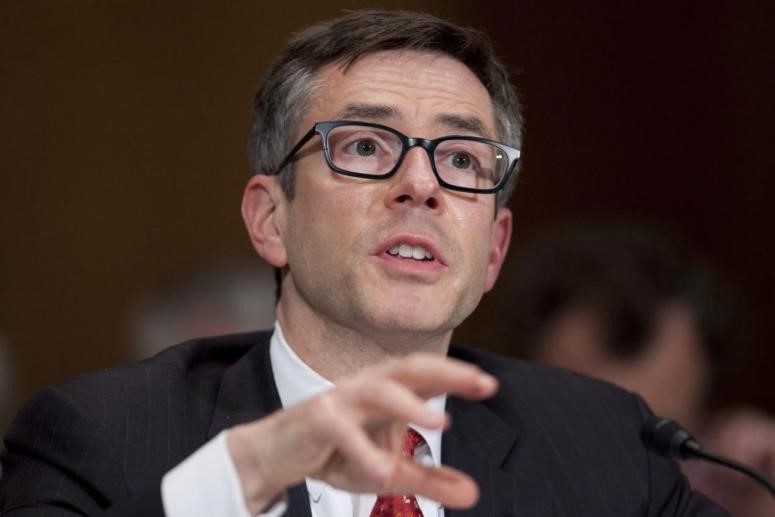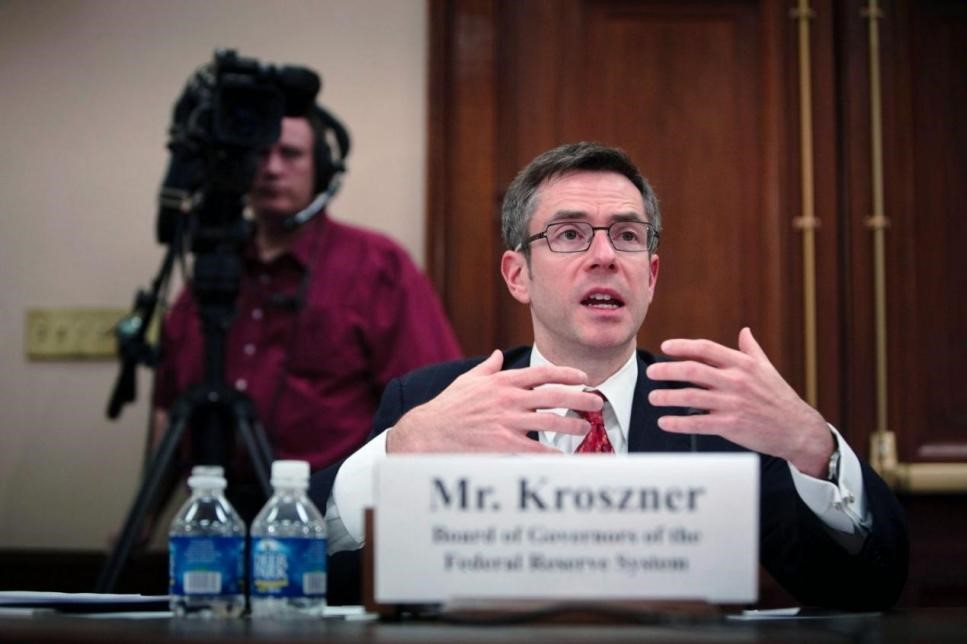知名经济学家警告,一条银行业新规将严重影响经济

银行业新规通常并不会引起公众的关注。《巴塞尔协议III》终局规则(B3E)则有些不同——而且吸引眼球的不仅仅是这个朗朗上口的漫威式绰号。
美国的知名银行家以及众多保守派议员、行业协会和游说组织纷纷抵制B3E。他们认为该规则将使消费者和企业付出高昂的代价。有反对者甚至斥巨资投放广告,说服选民“阻止巴塞尔终局”,因为它有可能导致经济放缓。
什么是B3E规则?B3E规则是由来自26个国家的监管者和央行官员组成的巴塞尔委员会(Basel Committee)为应对2007年至2008年全球金融危机(Global Financial Crisis)而制定的一套国际银行业改革措施(《巴塞尔协议III》)的最终版。
《巴塞尔协议III》的目的是完善银行抵御经济冲击和金融压力的能力,同时提高银行的透明度。但直到2023年7月,美联储(Federal Reserve)、美国货币监理署(Office of the Comptroller of the Currency)和美国联邦存款保险公司(Federal Deposit Insurance Corporation)才共同提出了《巴塞尔协议III》终局规则,最终确定了相关规定。
该规则拟将资产规模超过7,500亿美元的大型银行的资本要求提高16%至25%,而小型银行的资本要求将提高约11%。
B3E规则还要求银行使用标准化风险模型,改变风险加权资产的计算方法,并且到2028年在资本要求计算中必须使用名为“累计其他综合收益”(AOCI)的新指标。所有这一切都招致了银行的批评,这也在情理之中,因为一项研究显示,仅在2025年,B3E就可能使银行的营收损失350亿美元。而且,除了银行以外,从农民到美联储前官员,批评者大有人在。就连曾经在全球金融危机期间担任银行机构监督管理委员会(Committee on Supervision and Regulation of Banking Institutions)主席的美联储前理事兰德尔·S·克罗兹纳也公开表示反对。
现任芝加哥大学(University of Chicago)布斯商学院(Booth School of Business)诺曼·R·博宾斯经济学教授的克罗兹纳在最新发表的一篇论文中表示,B3E不仅会让银行付出高昂的代价,还会给全美消费者和企业造成“意外后果”。

克罗兹纳担心,从增加借贷成本、减少贷款供应,到降低股票市场流动性、激发风险更高的民间借贷,B3E可能弊大于利。
这位美联储的前理事在接受《财富》杂志采访时解释称,他主要担心的是,监管机构没有对《巴塞尔协议III》终局规则进行恰当的成本效益分析,而且目前的方案并没有解决金融体系面临的具体风险。相反,他认为该方案更像是一揽子规定。
他解释道:“生态系统在进化,风险也在变化,变革与改革总是必要的。但正如我在论文中所说的那样,我所担忧的是,我认为他们并没有针对他们所关注的具体风险很好地制定监管规则。”
克罗兹纳举例称,B3E规则提高了住宅房地产的资本要求,但并没有解决商业地产存在的潜在问题,而加息和创纪录的空置率令商业地产陷入危机。
最重要的是,克罗兹纳希望监管者退一步,暂时搁置《巴塞尔协议III》终局规则,先进行更深入的成本效益分析,然后再调整现有方案或者彻底重新制定规则。
他说:“他们要从评论员那里收集恰当的意见。评论员人数众多,几乎所有评论员都提出了合理的问题或关切,而这些正是在推进工作之前需要思考的潜在意外后果。”
消费者贷款成本更高,贷款供应减少
虽然提高资本要求可以使银行在面临经济或财务压力时更具韧性,但B3E的批评者指出,这也会增加借贷成本。
克罗兹纳认为这很糟糕,主要有两个原因。首先,银行会将增加的部分成本转嫁给最终用户。这意味着对创业者、退休金、共同基金以及只想买房买车的普通美国人而言,借贷成本增加,能够获得的贷款减少。他还表示,这尤其会影响“中低收入借款人和少数族裔企业”。
修改税收权益投资风险分类规则也将迫使银行在投资可再生能源时保留更多的资本。纽约梅隆银行(Bank of New York Mellon)的首席财务官德莫特·麦克多纳在今年1月对彭博社(Bloomberg)表示,这将“严重削弱”或者“消除”银行投资许多绿色能源项目的能力。
做市交易成本更高
银行在“做市”交易中扮演着关键角色,可以为股票、债务和其他市场的正常运作提供必要的流动性。但克罗兹纳在报告中警告说,银行可能因为B3E规则而决定“减少业务活动,甚至不再提供某些产品或服务”。
他说:“如果银行失去了做市的积极性,市场流动性可能就会受到影响,需要央行采取措施来稳定市场的市场失灵状况会变得更加频繁。”
克罗兹纳警告,做市成本增加还可能加剧市场波动,增加投资者的交易成本。他举例称,农民的套期保值做法可能会受到影响:农民通常会在丰收季期初通过购买期货合约对季节性收成进行套期保值,这些合约能够保证在农民收获后,买方可以按照特定的价格付款。但有多个农民协会最近致函监管部门,他们认为B3E规则会阻碍农民使用这类期货合约锁定价格的能力。
这只是提高资本要求影响银行做市能力的一个例子,但同样的情况可能在多个行业重演。这会导致全国企业获得的投资减少。克罗兹纳在报告里警告道:“投资减少会导致生产率增长下降,进而导致工人工资和整体经济增长放缓。”
公共向民间借贷的转变仍在继续
过去数十年,越来越多企业选择民间借贷,而不是向银行贷款。虽然民间借贷或者人们常说的私人信贷已经蓬勃发展成为一个价值1.7万亿美元的产业,但克罗兹纳仍然担心它会给金融体系带来风险。他警告道,民间借贷监管机构“掌握的信息较少,监控风险的能力也较弱,尤其是在危机之前和危机爆发期间。”
B3E会再次刺激民间借贷行业的发展。随着资本要求不断提高以及公共贷款机构标准不断变化,民间借贷将对最终用户更有竞争力,进而导致更多的波动和风险。

克罗兹纳在报告中指出:“因此,提高资本要求非但不能节省监管资源和增强冲击缓冲能力,反而可能需要监管机构提高警惕,导致监管者与银行之间的关系变得更脆弱,进而降低系统的整体安全性和稳健性。”
但银行反对终局规则是有原因的
尽管批评声不断,但《巴塞尔协议III》终局规则的支持者们则认为,该规则有助于提高银行系统的韧性,避免最糟糕的情况出现。他们表示,B3E将要求银行采用标准化经营风险模型。尽管这将耗资巨大,但却能让贷款机构进一步识别、应对以及防止在财务紧张时期或经济冲击后出现的问题。
这些规则还将强制银行到2028年在计算资本要求时使用“累计其他综合收益”。这一变化将迫使一些银行为债券组合中未实现的贷款损失储备资本。正如我们在2023年3月硅谷银行(Silicon Valley Bank)倒闭事件中所看到的,该银行倒闭的部分原因就是大量未实现的贷款损失,在这种情况下,执行这些规则可能是有意义的。
此外,值得注意的是,银行、首席执行官和游说者反对B3E规则,背后有重要的财务原因。据路透社(Reuters)报道,咨询公司奥纬咨询(Oliver Wyman)预测,到2025年,终局规则将导致银行营收减少350亿美元。包括信用卡公司在内的其他主要金融服务提供商也会受到重创。瑞银集团(UBS)的分析师在2023年夏天的一份报告里指出,根据B3E规则计算经营风险加权资产(RWA),对于大部分收入来自手续费的公司“尤其不利”。
克罗兹纳:我们需要更深入的成本效益分析
归根结底,克罗兹纳和其他许多B3E的反对者真正想要看到的是,更深入地分析这些新规则对经济的影响。正如克罗兹纳在他的报告中写道:“重要的是要考虑改革方案对家庭、企业、消费者和银行系统的其他最终用户的潜在影响,以及可能削弱而不是增强整个系统金融稳定性的意外后果。”
克罗兹纳教授认为,监管者只对B3E方案进行了“非常高水平的定性成本效益分析”, 在他看来,这些分析并不能够说明利大于弊。但这并不意味着克罗兹纳反对监管。
他告诉《财富》杂志:“我认为,我们应该避免更多还是更少监管的争论,因为人们在这个问题上很容易变得过于情绪化。我们应该做的是关注更有效的监管,讨论解决这个问题的最佳途径。”
克罗兹纳表示,我们应该考虑如何解决特定风险,例如加息可能给银行带来的问题,或者商业地产风险过大的威胁等。他说:“目前存在哪些风险,我们如何才可以谨慎周到地以最佳方式解决这些问题。这才是我想看到的。”(财富中文网)
译者:刘进龙
审校:汪皓
银行业新规通常并不会引起公众的关注。《巴塞尔协议III》终局规则(B3E)则有些不同——而且吸引眼球的不仅仅是这个朗朗上口的漫威式绰号。
美国的知名银行家以及众多保守派议员、行业协会和游说组织纷纷抵制B3E。他们认为该规则将使消费者和企业付出高昂的代价。有反对者甚至斥巨资投放广告,说服选民“阻止巴塞尔终局”,因为它有可能导致经济放缓。
什么是B3E规则?B3E规则是由来自26个国家的监管者和央行官员组成的巴塞尔委员会(Basel Committee)为应对2007年至2008年全球金融危机(Global Financial Crisis)而制定的一套国际银行业改革措施(《巴塞尔协议III》)的最终版。
《巴塞尔协议III》的目的是完善银行抵御经济冲击和金融压力的能力,同时提高银行的透明度。但直到2023年7月,美联储(Federal Reserve)、美国货币监理署(Office of the Comptroller of the Currency)和美国联邦存款保险公司(Federal Deposit Insurance Corporation)才共同提出了《巴塞尔协议III》终局规则,最终确定了相关规定。
该规则拟将资产规模超过7,500亿美元的大型银行的资本要求提高16%至25%,而小型银行的资本要求将提高约11%。
B3E规则还要求银行使用标准化风险模型,改变风险加权资产的计算方法,并且到2028年在资本要求计算中必须使用名为“累计其他综合收益”(AOCI)的新指标。所有这一切都招致了银行的批评,这也在情理之中,因为一项研究显示,仅在2025年,B3E就可能使银行的营收损失350亿美元。而且,除了银行以外,从农民到美联储前官员,批评者大有人在。就连曾经在全球金融危机期间担任银行机构监督管理委员会(Committee on Supervision and Regulation of Banking Institutions)主席的美联储前理事兰德尔·S·克罗兹纳也公开表示反对。
现任芝加哥大学(University of Chicago)布斯商学院(Booth School of Business)诺曼·R·博宾斯经济学教授的克罗兹纳在最新发表的一篇论文中表示,B3E不仅会让银行付出高昂的代价,还会给全美消费者和企业造成“意外后果”。
克罗兹纳担心,从增加借贷成本、减少贷款供应,到降低股票市场流动性、激发风险更高的民间借贷,B3E可能弊大于利。
这位美联储的前理事在接受《财富》杂志采访时解释称,他主要担心的是,监管机构没有对《巴塞尔协议III》终局规则进行恰当的成本效益分析,而且目前的方案并没有解决金融体系面临的具体风险。相反,他认为该方案更像是一揽子规定。
他解释道:“生态系统在进化,风险也在变化,变革与改革总是必要的。但正如我在论文中所说的那样,我所担忧的是,我认为他们并没有针对他们所关注的具体风险很好地制定监管规则。”
克罗兹纳举例称,B3E规则提高了住宅房地产的资本要求,但并没有解决商业地产存在的潜在问题,而加息和创纪录的空置率令商业地产陷入危机。
最重要的是,克罗兹纳希望监管者退一步,暂时搁置《巴塞尔协议III》终局规则,先进行更深入的成本效益分析,然后再调整现有方案或者彻底重新制定规则。
他说:“他们要从评论员那里收集恰当的意见。评论员人数众多,几乎所有评论员都提出了合理的问题或关切,而这些正是在推进工作之前需要思考的潜在意外后果。”
消费者贷款成本更高,贷款供应减少
虽然提高资本要求可以使银行在面临经济或财务压力时更具韧性,但B3E的批评者指出,这也会增加借贷成本。
克罗兹纳认为这很糟糕,主要有两个原因。首先,银行会将增加的部分成本转嫁给最终用户。这意味着对创业者、退休金、共同基金以及只想买房买车的普通美国人而言,借贷成本增加,能够获得的贷款减少。他还表示,这尤其会影响“中低收入借款人和少数族裔企业”。
修改税收权益投资风险分类规则也将迫使银行在投资可再生能源时保留更多的资本。纽约梅隆银行(Bank of New York Mellon)的首席财务官德莫特·麦克多纳在今年1月对彭博社(Bloomberg)表示,这将“严重削弱”或者“消除”银行投资许多绿色能源项目的能力。
做市交易成本更高
银行在“做市”交易中扮演着关键角色,可以为股票、债务和其他市场的正常运作提供必要的流动性。但克罗兹纳在报告中警告说,银行可能因为B3E规则而决定“减少业务活动,甚至不再提供某些产品或服务”。
他说:“如果银行失去了做市的积极性,市场流动性可能就会受到影响,需要央行采取措施来稳定市场的市场失灵状况会变得更加频繁。”
克罗兹纳警告,做市成本增加还可能加剧市场波动,增加投资者的交易成本。他举例称,农民的套期保值做法可能会受到影响:农民通常会在丰收季期初通过购买期货合约对季节性收成进行套期保值,这些合约能够保证在农民收获后,买方可以按照特定的价格付款。但有多个农民协会最近致函监管部门,他们认为B3E规则会阻碍农民使用这类期货合约锁定价格的能力。
这只是提高资本要求影响银行做市能力的一个例子,但同样的情况可能在多个行业重演。这会导致全国企业获得的投资减少。克罗兹纳在报告里警告道:“投资减少会导致生产率增长下降,进而导致工人工资和整体经济增长放缓。”
公共向民间借贷的转变仍在继续
过去数十年,越来越多企业选择民间借贷,而不是向银行贷款。虽然民间借贷或者人们常说的私人信贷已经蓬勃发展成为一个价值1.7万亿美元的产业,但克罗兹纳仍然担心它会给金融体系带来风险。他警告道,民间借贷监管机构“掌握的信息较少,监控风险的能力也较弱,尤其是在危机之前和危机爆发期间。”
B3E会再次刺激民间借贷行业的发展。随着资本要求不断提高以及公共贷款机构标准不断变化,民间借贷将对最终用户更有竞争力,进而导致更多的波动和风险。
克罗兹纳在报告中指出:“因此,提高资本要求非但不能节省监管资源和增强冲击缓冲能力,反而可能需要监管机构提高警惕,导致监管者与银行之间的关系变得更脆弱,进而降低系统的整体安全性和稳健性。”
但银行反对终局规则是有原因的
尽管批评声不断,但《巴塞尔协议III》终局规则的支持者们则认为,该规则有助于提高银行系统的韧性,避免最糟糕的情况出现。他们表示,B3E将要求银行采用标准化经营风险模型。尽管这将耗资巨大,但却能让贷款机构进一步识别、应对以及防止在财务紧张时期或经济冲击后出现的问题。
这些规则还将强制银行到2028年在计算资本要求时使用“累计其他综合收益”。这一变化将迫使一些银行为债券组合中未实现的贷款损失储备资本。正如我们在2023年3月硅谷银行(Silicon Valley Bank)倒闭事件中所看到的,该银行倒闭的部分原因就是大量未实现的贷款损失,在这种情况下,执行这些规则可能是有意义的。
此外,值得注意的是,银行、首席执行官和游说者反对B3E规则,背后有重要的财务原因。据路透社(Reuters)报道,咨询公司奥纬咨询(Oliver Wyman)预测,到2025年,终局规则将导致银行营收减少350亿美元。包括信用卡公司在内的其他主要金融服务提供商也会受到重创。瑞银集团(UBS)的分析师在2023年夏天的一份报告里指出,根据B3E规则计算经营风险加权资产(RWA),对于大部分收入来自手续费的公司“尤其不利”。
克罗兹纳:我们需要更深入的成本效益分析
归根结底,克罗兹纳和其他许多B3E的反对者真正想要看到的是,更深入地分析这些新规则对经济的影响。正如克罗兹纳在他的报告中写道:“重要的是要考虑改革方案对家庭、企业、消费者和银行系统的其他最终用户的潜在影响,以及可能削弱而不是增强整个系统金融稳定性的意外后果。”
克罗兹纳教授认为,监管者只对B3E方案进行了“非常高水平的定性成本效益分析”, 在他看来,这些分析并不能够说明利大于弊。但这并不意味着克罗兹纳反对监管。
他告诉《财富》杂志:“我认为,我们应该避免更多还是更少监管的争论,因为人们在这个问题上很容易变得过于情绪化。我们应该做的是关注更有效的监管,讨论解决这个问题的最佳途径。”
克罗兹纳表示,我们应该考虑如何解决特定风险,例如加息可能给银行带来的问题,或者商业地产风险过大的威胁等。他说:“目前存在哪些风险,我们如何才可以谨慎周到地以最佳方式解决这些问题。这才是我想看到的。”(财富中文网)
译者:刘进龙
审校:汪皓
New banking regulations don’t typically generate much interest from the general public. Basel III Endgame (B3E) is a bit different—and it’s not just the catchy, Marvel-esque nickname that’s drawing attention.
The nation’s top bankers—as well as numerous conservative lawmakers, industry associations, and lobbyists—have pushed back against B3E, arguing it will be costly for consumers and businesses. Some opponents have even spent heavily on ads telling voters to “Stop Basel Endgame” because of its potential to slow the economy.
What is B3E? It’s the finalization of an international set of banking reform measures (Basel III) developed by a group of regulators and central bank officials from 26 countries called the Basel Committee in response to the Global Financial Crisis (GFC) of 2007–08.
The goal of Basel III was to improve banks’ ability to withstand economic shocks and financial stress while increasing their transparency. But it wasn’t until July of last year, that the Federal Reserve, the Office of the Comptroller of the Currency, and the Federal Deposit Insurance Corporation jointly proposed Basel III Endgame to finalize the regulations.
The proposal would raise capital requirements for large banks, those with assets over $750 billion, by 16% to 25%, while smaller banks would be looking at a roughly 11% jump.
B3E would also require banks to use standardized risk models, alter the calculation of risk-weighted assets, and, by 2028, force the use of a new measure called “accumulated other comprehensive income,” or AOCI, in capital-requirement calculations. All of this has drawn criticism from banks—which makes sense, given one study shows B3E could cost them $35 billion in revenue in 2025 alone—but they aren’t alone. From farmers to former Fed officials, the proposal has its fair share of critics. Even Randall S. Kroszner, a former Federal Reserve governor who chaired the Committee on Supervision and Regulation of Banking Institutions during the GFC, is speaking out against the idea.
Kroszner, now the Norman R. Bobins professor of economics at University of Chicago’s Booth School of Business, argues in a new paper that B3E won’t just be costly for banks, it will have “unintended consequences” for consumers and businesses across the U.S.
From increasing borrowing costs and reducing the availability of loans to lowering equity market liquidity and incentivizing riskier private lending, Kroszner fears the costs of B3E may outweigh the benefits.
In an interview with Fortune, the former Fed governor explained that his main concern is that regulators have not done a proper cost-benefit analysis of Basel III Endgame, and, as currently written, it doesn’t address specific risks to the financial system. Instead, he argues, the proposal is more of a blanket package of regulations.
“The ecosystem evolves, risks evolve, there are always going to be changes and reforms that will be necessary. But my concern, as I outline in the paper, is that I just don’t think that they’ve done a very good job of tailoring the proposals to particular risk concerns they have,” he explained.
Kroszner gave the example of how the B3E proposal raises capital requirements for residential real estate, but doesn’t address potential issues with commercial real estate, which has been coping with a crisis amid rising interest rates and record vacancies.
Above all, Kroszner wants to see regulators take a step back, put Basel III Endgame on hold, and then do a more in-depth cost-benefit analysis before altering the current proposal or reworking it entirely.
“They’re getting the right input from the commentators,” he said. “They had an enormous number of commentators, almost all of which had reasonable questions or concerns. And those are exactly the kind of potential unintended consequences that you want to look at before moving forward.”
Higher costs and fewer loans for consumers
While higher capital requirements can make banks more resilient during times of economic or financial stress, critics of B3E note they also increase the cost of lending.
Kroszner argued this is bad for two key reasons. First, banks would likely pass on all or part of their higher costs to end users. That means higher borrowing costs—and fewer available loans—for entrepreneurs, pension funds, mutual funds, and average Americans who just want to buy a home or car. This would impact “low- and moderate-income borrowers as well as minority businesses” in particular, he added.
Changes to rules regarding the risk classification of tax-equity investments would also force banks to keep more capital on hand if they invest in renewable energy. Dermot McDonogh, chief financial officer of the Bank of New York Mellon, told Bloomberg last month that this would “severely reduce” or “eliminate” banks’ ability to invest in many green-energy projects.
More expensive market-making
Banks play a crucial role in “market-making,” providing the liquidity necessary for equity, debt, and other markets to function properly. But Kroszner warned in his report that banks might decide to “reduce their activities or even withdraw from providing some products or services” owing to B3E.
“If banks have disincentives to make markets, market liquidity may suffer, and market dysfunction requiring central bank action to stabilize markets may become more frequent,” he said.
Kroszner warned the rising cost of market-making could also lead to increased volatility and higher trading costs for investors. He gave the example of how farmers’ hedging practices could be affected: Farmers tend to hedge their seasonal harvest at the beginning of the season by buying futures contracts, which guarantee buyers will pay a certain price after they’ve harvested. But a group of farmers’ associations recently penned a letter to regulators arguing the B3E proposal would hinder farmers’ ability to use these futures contracts to lock in prices.
This is just one example of how rising capital requirements can affect banks’ market-making abilities, but the same scenario would likely be repeated in multiple industries. All of this could lead to reduced investment in businesses nationwide. And “reduced investment can lead to lower productivity growth, reducing both wage growth for workers and overall economic growth,” Kroszner warned in his report.
The public-to-private transition continues
Over the past few decades, an increasing number of businesses have taken to using private lending services rather than banks. But while private lending—or private credit, as it’s often called—has boomed into a $1.7 trillion industry, Kroszner worries it presents risks to the financial system. He warned private lending regulators have “less information and less ability to monitor and rein in risks, especially in the run-up to and in times of crisis.”
And B3E is set to jump-start the private credit industry yet again. Rising capital requirements and shifting standards for public lenders will make private debt options far more competitive for end users—and that could lead to more volatility and risk.
“Thus, rather than conserving supervisory resources and providing greater cushions against shocks, increasing capital requirements could paradoxically require greater vigilance by supervisors and generate more fragile interconnections, thereby potentially reducing the overall safety and soundness of the system,” Kroszner argued in his paper.
But banks are pushing back for a reason
Despite the consistent criticism, proponents of the Basel III Endgame proposal believe it will help make the banking system more resilient and prevent worst-case scenarios. They note B3E will require the standardization of operational risk models at banks. And although that will be costly, it could help improve lenders’ ability to recognize, prepare for, and prevent issues that come during times of financial stress, or after economic shocks.
The proposal will also force banks to use a measure called “accumulated other comprehensive income,” or AOCI, by 2028 when they calculate capital requirements. This change would force some banks to hold capital against unrealized loan losses in their bond portfolios. And as we saw in March 2023 with the collapse of Silicon Valley Bank, which was in part due to large unrealized loan losses, this regulation may be worth implementing.
Also, it’s important to note that banks, CEOs, and lobbyists have a significant financial incentive to avoid B3E. Banks’ revenues alone will take a $35 billion hit in 2025 from the proposal, according to consultancy firm Oliver Wyman, per Reuters. And other key financial service providers, including credit card companies, will also be hit hard. The calculation of operational risk-weighted assets (RWAs) under the B3E proposal is “especially punitive” for firms that derive most of their income from fees, UBS analysts explained in a note last summer.
Kroszner: We need a better cost-benefit analysis
At the end of the day, what Kroszner and many other opponents of B3E really want is a better analysis of how this new proposal will affect the economy. As Kroszner wrote in his report: “It is important to consider the potential impact of the proposed changes on households, businesses, consumers, and other end users of the system as well as unintended consequences that could reduce rather than increase financial stability for the system as a whole.”
The professor argued that regulators have only completed a “very high-level qualitative analysis of costs and benefits” of the B3E proposal, which, in his view, doesn’t support the conclusion that the benefits outweigh the costs. But that doesn’t mean Kroszner is against regulation.
“I think we should try to get away from the debate of more or less regulation, because people get very emotional about that. What we should try to do is focus on more effective regulation, on what’s the best way to solve this problem,” he told Fortune.
Kroszner said we should think about addressing specific risks, like the potential for rising interest rates to cause problems for banks or the threat of excessive commercial real estate exposure. “What are the risk issues that are out there, and how can we best address those specific issues while being very mindful and thoughtful,” he said. “That’s the thing that I want to see.”













